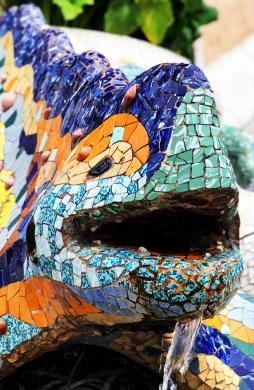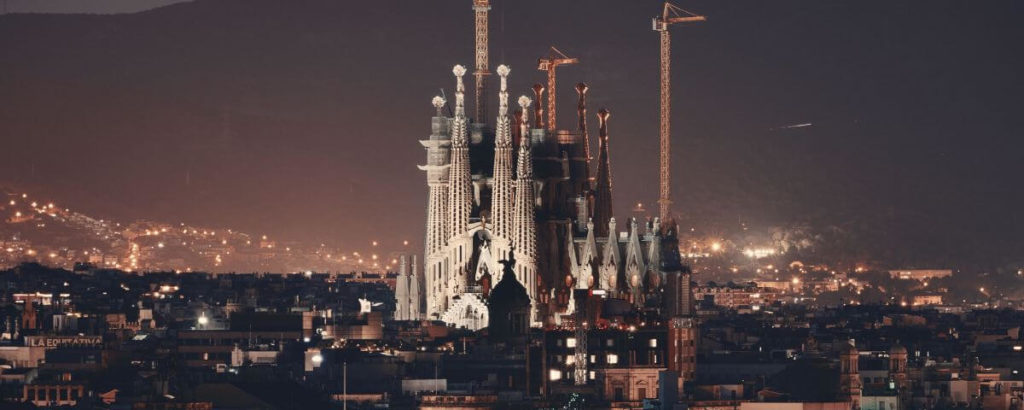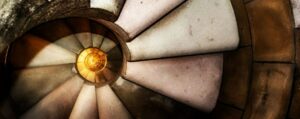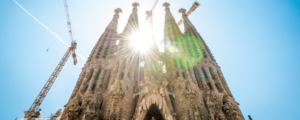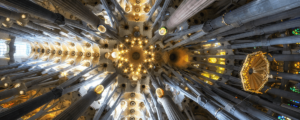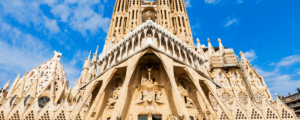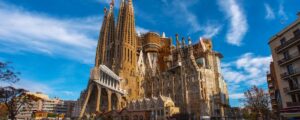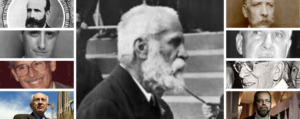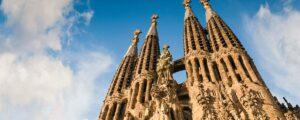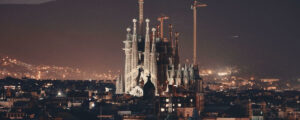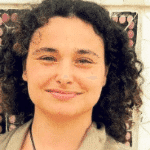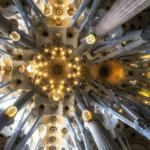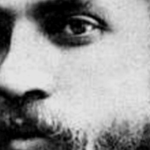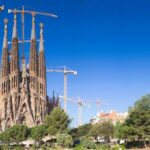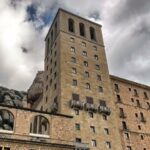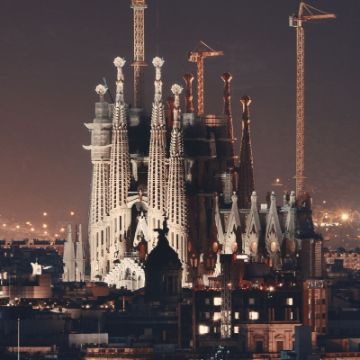
The History of the Sagrada Familia in Barcelona
LA SAGRADA FAMILIA: HISTORY OF AN INCREDIBLE CHURCH
The Sagrada Familia Church is the most visited monument in Spain (closely followed by the Alhambra in Granada), and it is considered the architect Antoni Gaudi’s masterpiece. A building that was started in 1882 and is still in construction, its history is as fascinating as its architecture. Why was it built? Who pays for it? How the historical events of the last century have affected it? When will it be finished? We discuss this and more in today’s post.
The origins of La Sagrada Familia
1
The Devotees of Saint Joseph
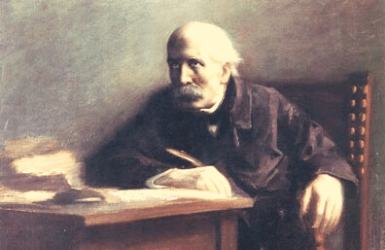
The "Associació de Devots de Sant Josep" was a Catholic society of devotees of Saint Joseph founded in 1866 by a book seller named Josep Maria Bocabella (1815-1892). The Catholic church was going through rough times: the "desamortizaciones" were laws to expropriate properties of the Church, passed first by the minister Mendizabal in 1836-37 and then again in 1855 by Pascual Madoz. Plus the working class was rapidly falling into atheism, not feeling supported by the religious institutions and being influenced by the anarchist movement.
But the middle and upper class remained faithful. Mr. Bocabella pilgrimed to Rome in 1872, and a church he saw in Loreto (Italy) on the way back gave him the idea of building a similar church in his hometown, Barcelona (Spain). He founded a society with the goal of collecting donations to fund his church. A church that would be an “expiatory temple”, meaning the donations would serve to “expire” (forgive) the sins of the donors as well as to build the church. It would be dedicated to Saint Joseph’s family: Jesus, Mary and Joseph, the “Sagrada Familia” (Holy Family, in English). To this day, there’s still descendants of Mr. Bocabella involved in the administration of its construction.
2
Francisco de Paula del Villar Project
The first stone was laid on March 19th, 1882 – Day of Saint Joseph. The construction started by excavating the ground to build the crypt that would be under the altar. However, after only one year of works, Villar resigned due to strong disagreements with Bocabella’s society about how the church should be built. The crypt had only been raised some 3 feet over the ground by then.
Antoni Gaudi and the Sagrada Familia Church
3
How Gaudi got involved in la Sagrada Familia construction
Nevertheless, Antoni Gaudi was a visionary and he saw here the opportunity of doing something magnificent. He convinced Bocabella to drop the original medieval-looking project and allow him to design a church that would attract believers from all over the world… but would take generations to be completed, just like the old cathedrals in Europe. And Bocabella accepted.
Gaudi then took over the completion of the crypt, which being already started, he couldn’t change much and it still looks quite traditional. He would also have preferred a different orientation, North-South for better use of the available land and sunlight, rather than aligned to the street grid of the Eixample district. But that couldn’t be changed either. He did find a way to bring natural light in, by means of a moat around the apse.
In 1885 Gaudi finished the construction of the first chapel of the Crypt, that of Saint Joseph, and mass started being celebrated there although the Crypt wouldn’t be completed until 1891. And between 1890-1893, already over the ground, was built the wall of the apse, the back of the actual church, also in Gothic-revival style, as it stands right on top of the limits of the crypt.
4
Building the Nativity Façade
The Nativity façade is just the Eastern side of the building, just a side entrance. And yet, with its 4 towers of around 100m (330ft) it’s impressive enough to rival with the front façade of the most important cathedrals in the world. The sculptures that decorate it tell the story of early years of Jesus, from the Annunciation to his youth helping his dad in their carpentry workshop or discussing with the elders at the synagogue. It is profusely decorated with natural elements, as a way to reinforce the idea of life and joy that brings the birth of Jesus.
Gaudi directed the construction works, at first still combining it with other projects, but after 1914 exclusively dedicated to the church, that had become his passion and obsession. He chooses the people that will pose as models for the sculptures, often neighbors that lived in the area. And works with the sculptors to find the exact posture and expressions he is looking for.
But more importantly, he is immersed in planning the rest of the church. And for that he builds plaster models in a variety of scales and creates an architectural language based in math and geometry. His mind works in a way that is closer to the way modern architects work in their computers than to what any architect of his time was doing then. And he makes sure that his younger assistants will know about it, so they can continue the construction when he isn’t there anymore.
Around 6 months before his sudden death, Gaudi decided to set up a little bed in his workshop in the church so he could stay overnight. He was too frail to walk every day over an hour uphill back home to Park Guell. Then in June 1926 he was hit by a tram. He was taken by a beggar, since the clothes he wore were humble and worn, and sent to a hospital for poor people. He died three days later, June 10th, his friends having just found him at the last minute.
Never having married, Gaudi had left his possessions to La Sagrada Familia. The sale of his home in Park Guell ensured there’d be some money to continue the works. His assistant Domenech Sugranyes took over the project, completing in the following months the 3 towers of the Nativity façade that were left. Gaudi had only lived long enough to see only the first one completed.
La Sagrada Familia during the Spanish Civil War and Franco's dictatorship
5
War damage
However, it was indeed attacked by revolutionaries that set the crypt and Gaudi’s workshop in fire as well as crashed some sculptures of the Nativity façade. As soon as the fire was over, Domenech Sugranyes together with a small group of brave followers risked their lives to recover as much as possible of the fragments of Gaudi’s plaster models, that exploded from the heat. Sugranyes was distraught about the loss, and he’d died in despair only two years later.
It was his assistant, Francesc de Paula Quintana, who took over the project when the war ended. He restored the crypt and started repairing Gaudi’s models, collecting as many pictures and sketches of them as he could find in press and private archives, as well as studying Gaudi’s math and geometry.
6
The Passion Façade and the dictatorship times
These are going to be decades of consolidation of the project. In 1954 are laid the foundations of the Passion Façade, and soon two collaborators will join Sugranyes directing the works: Isidre Puig Boada and Lluis Bonet i Garí, who both would become chief architects of the church in turn. The construction of the towers would expand until 1976, a year after Franco’s death.
The Passion façade is the Western side of the Sagrada Familia, and it’s dedicated to the Passion of Jesus – that is the story of his last three days. Gaudi was designing it when he contracted the Malta fevers and almost died from it. That experience made him realize that the Passion Façade had to look the total opposite of the Nativity Façade, since one represents joy and life, and the other death and suffering.
Paralelly, new sculptures are added to the Nativity façade, and collections start being organized to gather donations to fund the works. A museum is also created in the Sagrada Familia basement, to display models and plans, as well as to explain the history and architecture of the church.
Sagrada Familia Church and the return of democracy
7
The buildings on Mallorca street
However, in the 1970’s the construction was slow, and everyone was convinced the church would take ages to be completed. In 1975 the city council gave permission to build an apartment building right where the staircase had to go, with the condition that it’d be temporary and only until the Church had to be completed. The apartments were bought by families that were convinced they wouldn’t live long enough to see that.
Nowadays they live with the anxiety of not knowing what will happen to their homes, and not daring to invest much on repairs just in case they are made to move. They rally against the church, with occasional demonstrations and hanging banners in their balconies. And so far the city council doesn’t seem to be interested in having to relocate them and avoid the problem as much as possible.
8
Josep Maria Subirachs and the Passion Façade
Unfortunately, Gaudi’s idea of expressing the suffering and death here, as opposed to the joy of the Nativity façade, wasn’t conveyed efficiently enough to the public. Subirachs dark and sharp style was seen by the locals as a lack of respect for Gaudi’s plans, as an expression of the ego of Subirachs and an unwanted break from the more traditional and easier to understand style of the Nativity façade.
The controversy would last years, with even local intellectuals claiming to stop the works and leave the building site uncompleted, as a “tribute to the original architect”. Thankfully, the Board for the Construction of La Sagrada Familia disregarded the protests and the works carried on.
9
How the Olympic Games changed the history of the Sagrada Familia
In 1992 Barcelona hosted one of the most successful Summer Olympics in history. The city was cleaned up, historical buildings and entire neighborhoods of the Old Town were restored, the waterfront, beaches and marinas were recovered, and the city infrastructures were modernized and improved )from telecommunications to public transportation). And the Gaudi sites were put in value, images of them in all the videos preceding the competitions TV broadcasts.
All of a sudden, a city that used to be boring, industrial and grey became a vibrant tourism destination. And the church, that used to be visited by some 20,000 people per year, started being flooded with tourists. By the year 2000 they were getting over a million, and before the Covid pandemic in 2020 they had already reached 4 millions. The entrance fees, now considered a “donation to the works”, became the mean source of funding. And the speed of the construction rocketed.
Recent history of la Sagrada Familia in Barcelona
10
The construction of the naves
In 2007 the opening of a tunnel for the high speed train along Mallorca street endangered the works: the vibrations of the train could compromise the structure, and the Spanish Government rejected any other alternative path for the train. The Board of the Sagrada Familia gave priority to laying the foundations of the towers of the Glory Façade to occupy the underground space and build protective supporting walls before the construction of the tunnel began.
11
Sagrada Familia becomes an active church and a basilica
Since then, the crypt has continued to celebrate mass daily, but the main naves of the church have also been used for Sunday mass. During the first years people could attend by invitation only (issued by the Bishopric on request), and later on on first-come first-served basis. And for a few months before the Covid pandemic there was a Saturday evening mass as well.
The Basilica also hosts occasional concerts and special masses on Christmas and Easter, and more rarely has been closed for religious events organized by the Barcelona Bishopric. The religious cerimonies are free of charge, but attendants must leave the premises after it’s over, so visitors with paid tickets can come in afterwards.
12
Recent achivements
Unfortunately, in 2020 the Covid pandemic hit. The church was forced to close to the public for over a year, and for months the only works that could be carried one where tasks that the architects could perform remotely: all the on-site building was stopped. No visitors also meant no money, and the progress of the construction suffered from it, too. The dream of completing the church by 2026, year of the one hundred anniversary of Gaudi’s death, was gone.
But as Gaudi used to say “My Boss, up there (in Heaven) can wait”. It was decided to focus all the efforts and resources in one single project rather than several at once. And this is how in December 2021 the tower of the Virgin Mary, the second tallest, was completed and topped with a beautiful glass star. It had been decades since another tower had been finished.
13
What will the future bring?
What’s missing? the 4 towers of the Evangelists, the tower of Jesus Christ, one more sacristy, a back chapel, two baptisteries and a full façade: the Glory. And that’s just to mention the structure, which is what they aim to finish hopefully in the next years. But then there’s also the 2 organs that will be connected to some 50 tubular bells that need to go inside the towers.
And the sculptures of the Glory façade describing the Apocalypses and the raise of Jesus to the Glory of God. It’s even too early to think about choosing the artist who will take care of them. And then of course, there’s the bridge over Mallorca street and the entrance staircase. All that, my friend, will probably be the next generation who will live to see it…
Planning to visit the Basilica de la Sagrada Familia?
14
Visit information
- ADDRESS. Mallorca, 401 (Barcelona, 08013 | Spain)… Even if the visitors access is from Marina street.
- WEBSITE. https://sagradafamilia.org/
- OPENING HOURS. The basilica opens at 9AM everyday unless there’s mass. The closing time depends on the sunset and varies from month to month.
- TICKETS. There are no physical ticket offices anymore. All tickets must be purchased on line and they sell out days in advance. Don’t wait until last minute to get them!
- SUBWAY STATION: Sagrada Familia, on lines L2 (pink) and L5 (blue).
15
Take one of our private tours of Sagrada Familia
16
Further reading about La Sagrada Familia...
I hope you enjoyed learning about the history of Sagrada Familia in Barcelona!
Marta
RESEARCHING FOR A TRIP IS TIME-CONSUMING…
Need more inspiration?
Our 100% FREE Barcelona Collection will give you everything you need to organize the trip of your lifetime to Barcelona.
BEST INSIDER TIPS FROM THE PROS!
